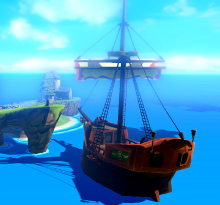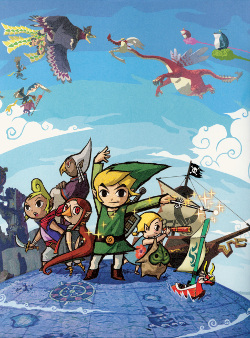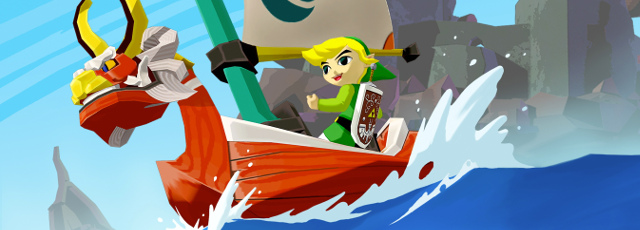Revisiting the Great Sea
Posted on April 19 2013 by Hanyou
 Overworlds tend to be the most memorable parts of Zelda games. While most of the gameplay generally takes place in the dungeons or towns scattered throughout, the overworld shapes the character and tone of a game.
Overworlds tend to be the most memorable parts of Zelda games. While most of the gameplay generally takes place in the dungeons or towns scattered throughout, the overworld shapes the character and tone of a game.
The Great Sea is one of the most interesting locations yet featured as an overworld. While some may dislike the Triforce quest or the supposed emptiness of the Great Sea, it no doubt defined and summarized the basic character and tone of The Wind Waker. Watching the King of Red Lion’s sails catch the wind, pushing ever forward to uncharted islands, was an experience not quickly forgotten. That the game placed a focus on the exploration of the Great Sea — on treasure maps, mini-dungeons, and a cryptic, sometimes frustrating Triforce quest — is no surprise. The ocean permeated the lore and even the visual finesse of The Wind Waker.
We’ve since seen it in Phantom Hourglass, which took a fundamentally similar approach. Once again, the ocean was pocked with small islands, some with their own challenges. This time, however, they felt a little bit larger in context of the game and a little more pivotal to the story.
That said, there is a good deal of untapped potential here. Whether or not you liked The Wind Waker and Phantom Hourglass’ approaches to the Great Sea — it is, after all, highly controversial — it would be unfortunate to let this location go. I believe that The Wind Waker best captured the spirit of adventure that marked the original Legend of Zelda. The Great Sea felt big and it was different from anything else on the market when it was released. As things stand, there still isn’t much competition, and it still displays plenty of potential as a premise. It’s well worth revisiting.
 What could a new Great Sea look like? Well, we’re already getting a re-release of The Wind Waker with an overhauled art style, but Nintendo could take things a step further. Something that hews more closely to a neutral art style like Ocarina of Time’s could make it feel like an entirely different place, while still capturing the sense of openness that naturally comes with the setting. While the style need not be “realistic” — no Zelda games have ever featured a completely realistic style — it could be a bit more natural. As things stand, however, this is the least important element; whatever Nintendo chooses to do in terms of art style, it usually works, and it almost always takes people by surprise. There’s no reason the Great Sea should be any different from the various land-based Zelda overworlds in this respect.
What could a new Great Sea look like? Well, we’re already getting a re-release of The Wind Waker with an overhauled art style, but Nintendo could take things a step further. Something that hews more closely to a neutral art style like Ocarina of Time’s could make it feel like an entirely different place, while still capturing the sense of openness that naturally comes with the setting. While the style need not be “realistic” — no Zelda games have ever featured a completely realistic style — it could be a bit more natural. As things stand, however, this is the least important element; whatever Nintendo chooses to do in terms of art style, it usually works, and it almost always takes people by surprise. There’s no reason the Great Sea should be any different from the various land-based Zelda overworlds in this respect.
Plotwise, there is plenty of room for further development in The Wind Waker’s timeline. Not only is it established that there are lands beyond Hyrule and thus other regions of ocean to explore, but a new Hyrule was founded on a new continent after such exploration and charting of new seas. The Wind Waker ends with the promise of more adventures on the Great Sea, but unfortunately, the players didn’t get to experience most of those adventures. What we were left with, while good, didn’t expand on The Wind Waker’s premise in terms of either plot or gameplay. There’s plenty of room to still do so.
Where else could the Great Sea go? Well, while The Wind Waker certainly offered up the spirit of exploration and adventure, it was still localized to Hyrule. There weren’t opportunities to discover new lands on the Great Sea. Part of The Wind Waker’s charm is its constant throwbacks to previous games, specifically Ocarina of Time and the mythology it helped forge. As such, it felt like part of the conventional, circular plot expected of Zelda games.
Phantom Hourglass did have a bit more mystery about it, but it sacrificed some of the grandeur and majesty of its predecessor, due at least in part to the limitations of the DS. In any case, there is the sense that less of the game is “real” and concrete, which further prevents the full realization of the Great Sea’s potential.
 What would be interesting to see is a protagonist — either a brand new Link or the Hero of the Winds; it doesn’t matter — in an entirely foreign land without the slightest idea of what to expect. This could allow the game to broach brand new territory, both in an overarching main quest and in smaller quests and plot points. While the developers wouldn’t need to take full advantage of the potential of such a setting, expansion on the Great Sea would both develop the same ideas that made The Wind Waker so special and utilize new scenarios and settings.
What would be interesting to see is a protagonist — either a brand new Link or the Hero of the Winds; it doesn’t matter — in an entirely foreign land without the slightest idea of what to expect. This could allow the game to broach brand new territory, both in an overarching main quest and in smaller quests and plot points. While the developers wouldn’t need to take full advantage of the potential of such a setting, expansion on the Great Sea would both develop the same ideas that made The Wind Waker so special and utilize new scenarios and settings.
Which is something we haven’t seen yet: Variety. The Wind Waker and Phantom Hourglass were both predominantly tropical. This was probably restricted by the size of the islands, especially in The Wind Waker; they were all very small, and there wasn’t much room for a proper landscape to develop. Imagine small or large continents with deserts, icy mountains, jungles, and the other tropes we’ve come to expect from games. Imagine multiple kingdoms with different politics, engaged in an all-out war. These are only some of the potential benefits of a larger ocean-based setting with larger islands. It would have implications not only for the gameplay (which would, like Skyward Sword, offer plenty of land-based action in spite of the seafaring setting), but, inevitably, for the story, which could have a scale that a strictly land-based setting would not necessarily offer by default.
That said, part of what made The Wind Waker’s ocean feel like, well, an ocean was the fact that the islands were so far apart. There was something liberating about setting sail and letting the wind carry you for a while. However, it was also the series’ least navigable world, as it demanded more of the player in terms of planning and less in terms of transport. It was not inherently engaging unless you were invested in the setting. Still, it would be a shame for another game on the Great Sea to reduce the scale of the ocean itself.

 Author: Hanyou
Author: Hanyou
Hanyou has worked for the article staff, both as a writer and as an editor, for over a year. He has also been an active member of the Zelda Dungeon forums since 2008 and an avid fan of the Zelda franchise since 1998. He has degrees in writing.



